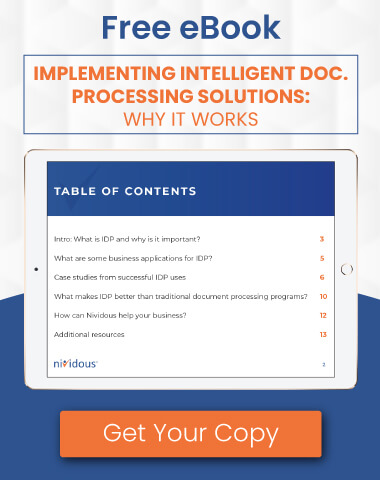When we look at information on a screen or on a piece of paper, our brains perceive that information, process it, and categorize it, seemingly within an instant. Our brains are powerful in that way, capable of reading 200-400 words in a single minute. Even more impressive is the research done by a team of neuroscientists at MIT that found the human brain can process an entire image after seeing it for as little as 13 milliseconds.
Modern technology is starting to catch up with the capabilities of the human brain in some areas. Intelligent Document Processing, or IDP, is a powerful technology that can extract and process information on a level not unlike our brains. IDP processes documents with a high degree of speed and accuracy—frequently outperforming human employees. IDP technologies allow for the extraction of structured data from completely unstructured sources. The data extracted using IDP can then be used for intelligent automation of an end-to-end business process. After being relieved of repetitive and basic document processing tasks, your workers can then spend more time on the more challenging work that only they can do.
IDP can also be called document automation—an end-to-end system of processing documents at scale. Read further to learn how IDP works, and see some valuable intelligent document processing use cases for diverse business fields. (For even more support of IDP’s usefulness, check out these IDP statistics!)
Want to automate your manual processes with IDP?
Learn about our intelligent automation platform and low-cost Quick Start Program to find out how it can save you time and money.
What is Intelligent Document Processing?
Intelligent Document Processing evolved from a technology called Optical Character Recognition, or OCR. OCR has been around quite some time and still has a role to play in IDP, but combining it with more advanced Artificial Intelligence (AI) technologies makes it much more accurate and useful.
- OCR captures character based content from unstructured images in a digital format, which enables machine processing.
- IDP can identify regions for extraction, classify content and document types, perform data validation, and analyze language and context to capture more information with higher accuracy than OCR on its own.
When OCR is combined with AI technologies—such as Natural Language Processing (NLP), Machine Learning (ML), and Computer Vision (CV)— you can consider the result to be IDP, or holistic document automation. In IDP, these technologies work together, making it possible for pixels to be translated into characters, recognized as text, combined to make words, and analyzed to ensure the words make sense in context.
All of these cross-checks allow for better extraction of content than a business could achieve with any one of the technologies on its own.
| NOTE: IDP isn’t just about paper documents. These same technologies can be used to process unstructured data on screens, allowing IDP to retrieve data from virtually anywhere and send it to the appropriate place. This is especially useful for legacy systems or anything that must be accessed through a terminal emulator. |
Intelligent Document Processing Use Cases (By Industry)
How is Intelligent Document Processing used in insurance?
Businesses in all industries occasionally need to reconcile data—cross-check and verify it by comparing it with data located in a different place. This level of document automation is extremely important for industries like insurance, healthcare, and banking (more on the latter two below). An effective cross-checking method produces a higher accuracy rate, a higher volume of documents processed, and overall faster processes.
Insurance companies have many reconciliation use cases that involve comparing and validating from multiple different sources. They use IDP to perform these reconciliations quickly and accurately with detailed reports produced and used for other downstream tasks, such as account creation, custom policy quoting and underwriting.
Using IDP for data reconciliation saves thousands of staff-hours and can reduce process turnaround time by more than 50%, as it has for multiple Nividous insurance clients.
Eager to transform your insurance operations with Artificial Intelligence?
Watch our on-demand webinar to discover actionable strategies on how AI and intelligent automation can empower your business to conquer soaring costs and meet the evolving expectations of customers.
How is Intelligent Document Processing used in health care?
IDP is very helpful in document automation for healthcare. IDP can assist medical providers with patient identity verification and insurance pre-authorization: Medical providers, after scanning a patient’s insurance card or ID, can use IDP to instantly extract the patient’s member ID and insurance and validate coverage using the appropriate provider portal, to ensure that a patient will be covered for a given visit or procedure within minutes, if not seconds.
Nividous has also employed IDP to help large healthcare companies process seemingly insurmountable numbers of incoming faxes—each file hundreds or thousands of pages long.
Here are some other examples of what IDP can do in health care:
- Extract data for different patients into different categories
- Process data from faxes, physical mail, and other documents
- Classify sensitive data into various locations within a healthcare organization
- Recognize errors, flag those documents for user intervention, and apply feedback to make sure the same error is solved without user intervention the next time
In all these cases, IDP was invaluable in reducing manual effort. It can increase health care productivity as much as 65% and reduce costs by 45% when applied properly.
How is Intelligent Document Processing used in life sciences?
In one case, IDP was deployed successfully to help a life sciences company that works with pharmaceutical companies on their drug applications.
The drug application process requires pulling in large amounts of data from disparate sources and eventually culling it all down into the final application document. For many pharmaceutical companies, it requires hours of manual effort to sort through sources and put them together in the necessary application.
Nividous used IDP to help this company automate the initial data-gathering and application-building processes. A human worker then takes over to review the different sources and elements of the drug application. This change meaningfully reduced the manual labor involved, as well as time and money. Read the full case study here.
How is Intelligent Document Processing used in finance and banking?
Loan processing is a common use case for IDP in finance.
Loan applications, whether they are constructed manually via handwritten notes from a loan officer or on a web-based form, require a lot of data from many different sources in order for the loan application to be submitted, reviewed, approved, disbursed and serviced. IDP can extract data from the initial application and insert it into the bank’s own loan origination application. This data, retrieved within an instant, allows bank employees to quickly review loan terms and decide whether an applicant will be approved.
IDP can also assist banking and finance firms by:
- Performing loan-focused customer data collection, such as data from pay stubs and investments
- Verifying application data
- Retrieving customer or prospect contact data for follow up
Are you ready to transform financial services with AI and automation?
Watch our expert-led on-demand webinar to learn how AI and intelligent automation are transforming payment processing.
How is Intelligent Document Processing used in IT?
In IT, IDP can be used to support the help desk.
Customers get support for products and services by calling, emailing, chatting, or even texting. When the IT department receives that information, they have to triage to figure out what departments to contact to solve your problem.
IDP makes it possible for IT to perform that processing much faster. For example, IDP can analyze the text of an email to determine whether the sender is happy, discouraged, or irate about your product or problem. This insight can then be used to route the message to a help desk associate who’s best equipped to help you with your problem, leading to an increase in customer satisfaction and reduced turnaround times.
Where Intelligent Document Processing Use Cases Lead
Whether you’ve pinpointed a specific Intelligent Document Processing use case at your own business, or you simply have a business challenge you suspect IDP and intelligent automation could solve, we’d love to hear from you. Reach out to us today to meet with one of our experts!





![The Path Forward for Intelligent Automation [2024 Trends] Blog Feature](https://nividous.com/wp-content/uploads/2024/05/The-Path-Forward-for-Intelligent-Automation-blog-feature-1.webp)